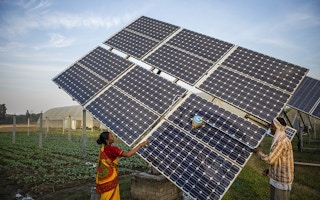From an environmental, climate, and health perspective, there is almost unanimous consensus that coal is a disaster. It is a significant source of outdoor air pollution, which kills more than 3.3 million people annually; causes smog and acid rain; as well as generates millions of tonnes of climate change-causing greenhouse gas emissions. With the ratification of the Paris Agreement in 2016, reducing these emissions quickly and significantly has become a global priority.
To continue reading, subscribe to Eco‑Business.
There's something for everyone. We offer a range of subscription plans.
- Access our stories and receive our Insights Weekly newsletter with the free EB Member plan.
- Unlock unlimited access to our content and archive with EB Circle.
- Publish your content with EB Premium.
But at the same time coal provides about 40 per cent of the total electricity worldwide. It is forecast that, even with radical improvements in technology, demand for electricity will double by 2030. Phasing out coal from the global fuel mix will not happen overnight; it will likely need concerted effort at increasing the share of alternatives to achieve even a gradual shift.
Therefore, to facilitate a shift away from coal, we need to find a replacement that produces the same amount of electricity without disrupting power supply to consumers. And we need to get this done quickly, because the air pollution crisis needs to be tackled urgently.
An important way to reduce coal’s environmental impact is to make coal-fired power plants cleaner and more efficient; but upgrading old plants with new equipment is an expensive process. Sometimes, it is so prohibitively expensive that older plants may be retired altogether.
Planned carefully, some of these replacement decisions can be accelerated, and could perhaps be part of the immediately needed solution to address air quality.
With the prices of solar dropping low enough to warrant a real discussion about substitution of energy sources on the grid, it is worth exploring the role solar energy can play in decommissioning existing plans. This is in addition to ongoing discussions about how it can be used to meet future capacity additions.
Here is a three-point “renewables-for-coal” scheme to incentivize the decommissioning of ageing coal plants.
“
Countries have to fulfil moral obligations to their people to supply power at affordable rates, but as we endeavor to find solutions that are both high on impact and immediate, creating the space to consider innovative mechanisms must be front and center of our imaginations.
Renewables for coal
Here is how the scheme would work:
First, an ageing coal plant is identified as a candidate for potential decommissioning. At the same time, a renewable energy power plant is identified which can supply enough power to substitute the coal plant that is to be closed. This renewable plant is then offered an incentive, in the form of a “special tariff” which is higher than the tariff offered to usual renewable energy plants, or the feed-in-tariff where there is one. The “special tariff” would give developers an incentive to build plants that match the size of coal plants.
This special tariff is calculated such that it includes the cost of generating power from the old coal plant for the remaining life. For example, if the identified coal plant had five years of remaining life and the utility was obligated to make payments until the end of the plant’s useful life, then the price that utility would have paid the coal plant is transferred as an incentive to the new renewable energy plant.
The remaining levelized cost of energy of the old coal plant—that is, the price of energy per kilowatt hour—is added to the tariff in the power purchase agreement of the new renewable energy plant to arrive at this “special tariff”. That is incentive number one.
Naturally, this assumes that the renewable energy plant is of substitutable capacity, the grid is stable enough to handle new capacity, transmission infrastructure is available and so on. But these are manageable. The cost of decommissioning is assumed to be cost-neutral; it would have happened anyway since the coal plant was ageing.
Now for the second incentive. The new renewable energy plant – for example, solar power - would be offered a tariff incentive only; capital investment would still need to be sought by the renewables’ developer.
Since most to-be-commissioned plants are in countries where power purchase agreements are not always bankable, as a second incentive to accelerate decommissioning, international climate funds or specialized vehicles of multilateral agencies could become the counterparty. In other words, international climate finance would be paying for the incremental difference in tariff between the old coal plant and the new renewable energy plant. The offtaker would be a highly rated fund that in turn would make the power purchase agreements bankable.
However, local currency risk often remains a barrier to foreign capital. But that is manageable as well. So, let’s consider incentive number three: Setting the special tariff in US dollars. This would make the transaction viable in the host country and hedge against local currency risks. It also means that the project developer could access investment in foreign exchange and not have to bear exposure to local currency fluctuation.
You might be thinking, what if the renewable energy project got “too much money”? In other words, what if the special tariff was so high that plants benefited from windfall returns? Most tariff setting is premised on an acceptable level of investment returns to the power producer; in India, for example, the range tends to be 15-18 per cent in Indian rupee terms.
But since this scheme is being considered as an international one and we are dealing with foreign exchange, acceptable levels of returns for investment funds ranges between 8 and 10 per cent, depending on the country. This means there would be a cap on the permissible returns and denominating the power purchase contract in foreign currency will enable the renewables developer to seek foreign investment.
To account for differences in project costs, investment returns would be calculated at average project cost estimates for a typical solar plant working under commonly used technical assumptions. Again, managing these technical assumptions is commonplace and practiced by utilities all over the world when setting bespoke tariffs for new technologies. Setting such a limit on the returns will prevent the renewable energy developer earning disproportionate profits, yet provide enough incentive to attract large scale developers.
So, there we have three very significant incentives offered to project developers.
Many countries, especially in the Asian region, already have plans to decommission their old coal plants. But, decommissioning takes time. Countries have to fulfil moral obligations to their people to supply power at affordable rates, but as we endeavor to find solutions that are both high on impact and immediate, creating the space to consider innovative mechanisms must be front and center of our imaginations.
International climate funds have an important role to play, as do members of the international community. It is time we came together to find practical and immediate solutions. And that needs outside-the-box thinking.
Mahua Acharya is assistant director-general of the intergovernmental agency, Global Green Growth Institute. Views are personal. This article was written exclusively for Eco-Business.









